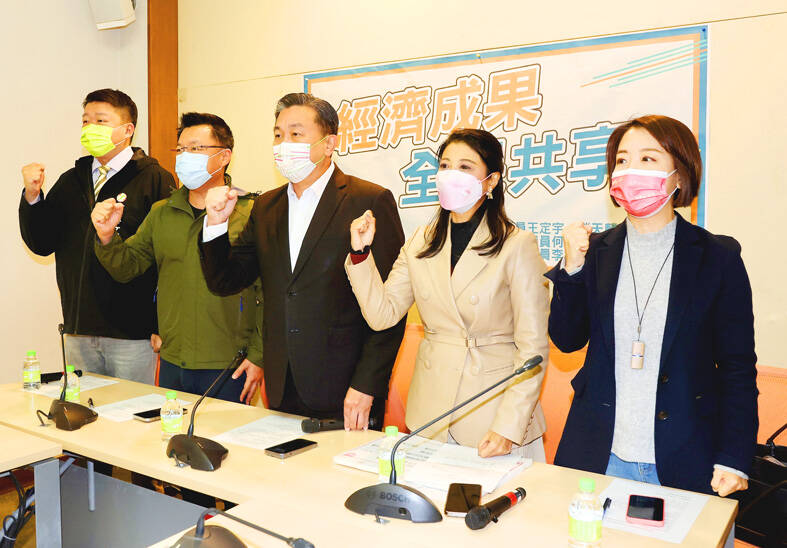The government might issue vouchers to redistribute this year’s surplus tax revenue, the Ministry of Finance said yesterday following a call from lawmakers.
Lawmakers on the legislature’s Finance Committee asked Acting Minister of Finance Frank Juan (阮清華) about the possibility of redistributing surplus tax revenue.
Juan said a redistribution scheme would have to undergo legislative review, so it would be easier to issue vouchers similar to the stimulus vouchers issued to encourage consumer spending during the COVID-19 pandemic.

Photo: CNA
Although tax revenue exceeded the general budget planned for this year, it fell into a deficit when special budgets were taken into consideration, he added.
As such, redistributing the surplus could increase the government’s debt burden and should be carefully deliberated, he said.
Juan promised to bring the issue to the Executive Yuan and discuss it with government agencies.
Separately, Democratic Progressive Party (DPP) legislators Wang Ting-yu (王定宇), Chao Tien-lin (趙天麟) and Michelle Lin (林楚茵) from the party’s Taiwan Forward faction proposed at a news conference ways to return the surplus tax revenue to the public.
Tax revenue in the first 11 months of this year exceeded NT$3 trillion (US$97.69 billion) for the first time, and by the end of the year might exceed the planned budget by NT$450 billion, they said.
The government should return the surplus to the public in cash or voucher form before the Lunar New Year holiday next month, they said.
It should also provide debt relief to 840,000 students in Taiwan and offer further economic relief packages to traditional industries, which were affected the most by COVID-19, they said.
Although Taiwan’s overall economic situation has ostensibly been good during the pandemic, that might only be the case for specific industries such as semiconductors and technology, Wang said.
Traditional industries, including service providers, caterers and food markets, have been struggling, he added.
Many people have complained to Vice President William Lai (賴清德) at local forums that the government’s economic relief packages came with too many limitations and inconveniences, Chao said.
The tax surplus mainly came from corporate income taxes, Lin said, adding that large companies performed well during the pandemic and their factories managed to deliver products on time.
However, the food industry, and small and medium-sized enterprises have been negatively affected by the pandemic, she said.
Former New Taipei City councilor Ho Po-wen (何博文) and former Hsinchu City councilor Lee Yen-hui (李妍慧) of the DPP urged the government to share the surplus with the public so that people can enjoy the Lunar New Year.
Later yesterday, Executive Yuan spokesman Lo Ping-cheng (羅秉成) said that President Tsai Ing-wen (蔡英文) would convene a national security meeting to discuss the issue based on the economic conditions at home and abroad.
The Executive Yuan would make an announcement as soon as a concrete policy is formulated, he added.

LIMITS: While China increases military pressure on Taiwan and expands its use of cognitive warfare, it is unwilling to target tech supply chains, the report said US and Taiwan military officials have warned that the Chinese People’s Liberation Army (PLA) could implement a blockade within “a matter of hours” and need only “minimal conversion time” prior to an attack on Taiwan, a report released on Tuesday by the US Senate’s China Economic and Security Review Commission said. “While there is no indication that China is planning an imminent attack, the United States and its allies and partners can no longer assume that a Taiwan contingency is a distant possibility for which they would have ample time to prepare,” it said. The commission made the comments in its annual

DETERMINATION: Beijing’s actions toward Tokyo have drawn international attention, but would likely bolster regional coordination and defense networks, the report said Japanese Prime Minister Sanae Takaichi’s administration is likely to prioritize security reforms and deterrence in the face of recent “hybrid” threats from China, the National Security Bureau (NSB) said. The bureau made the assessment in a written report to the Legislative Yuan ahead of an oral report and questions-and-answers session at the legislature’s Foreign Affairs and National Defense Committee tomorrow. The key points of Japan’s security reforms would be to reinforce security cooperation with the US, including enhancing defense deployment in the first island chain, pushing forward the integrated command and operations of the Japan Self-Defense Forces and US Forces Japan, as

‘TROUBLEMAKER’: Most countries believe that it is China — rather than Taiwan — that is undermining regional peace and stability with its coercive tactics, the president said China should restrain itself and refrain from being a troublemaker that sabotages peace and stability in the Indo-Pacific region, President William Lai (賴清德) said yesterday. Lai made the remarks after China Coast Guard vessels sailed into disputed waters off the Senkaku Islands — known as the Diaoyutai Islands (釣魚台) in Taiwan — following a remark Japanese Prime Minister Sanae Takaichi made regarding Taiwan. Takaichi during a parliamentary session on Nov. 7 said that a “Taiwan contingency” involving a Chinese naval blockade could qualify as a “survival-threatening situation” for Japan, and trigger Tokyo’s deployment of its military for defense. Asked about the escalating tensions

The Ministry of Economic Affairs said it plans to revise the export control list for strategic high-tech products by adding 18 items under three categories — advanced 3D printing equipment, advanced semiconductor equipment and quantum computers — which would require local manufacturers to obtain licenses for their export. The ministry’s announcement yesterday came as the International Trade Administration issued a 60-day preview period for planned revisions to the Export Control List for Dual Use Items and Technology (軍商兩用貨品及技術出口管制清單) and the Common Military List (一般軍用貨品清單), which fall under regulations governing export destinations for strategic high-tech commodities and specific strategic high-tech commodities. The